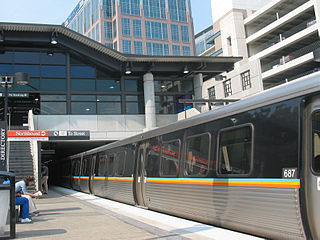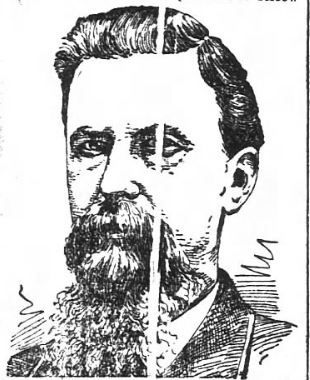
Little Five Points is a district on the east side of Atlanta, Georgia, United States, 2+1⁄2 miles (4.0 km) east of downtown. It was established in the early 20th century as the commercial district for the adjacent Inman Park and Candler Park neighborhoods, and has since become famous for the alternative culture it brings to Atlanta. It has been described as Atlanta's version of Haight-Ashbury, a melting pot of sub-cultures, and the bohemian center of the Southern United States.

Mercer University is a private research university with its main campus in Macon, Georgia. Founded in 1833 as Mercer Institute and gaining university status in 1837, it is the oldest private university in the state and enrolls more than 9,000 students in 12 colleges and schools. Mercer is a member of the Georgia Research Alliance. It is classified as a "R2: Doctoral Universities — High research activity".
Standing Peachtree was a Muscogee village and the closest Indian settlement to what is now the Buckhead area of Atlanta, Georgia. It was located where Peachtree Creek flows into the Chattahoochee River, in today's Paces neighborhood. It was located in the borderlands of the Cherokee and Muscogee nations. It is referred to in several documents dating as far back as 1782.

Centennial Olympic Stadium was the 85,000-seat main stadium of the 1996 Summer Olympics and Paralympics in Atlanta, Georgia, United States. Construction of the stadium began in 1993, and it was complete and ready for the opening ceremony in July 1996, where it hosted track and field events and the closing ceremony. After the Olympics and Paralympics, it was reconstructed into the baseball-specific Turner Field, used by the Atlanta Braves of Major League Baseball for 20 seasons (1997–2016). After the Braves departed for Truist Park, the facility was purchased by Georgia State University, which rebuilt the stadium a second time as Center Parc Stadium, designed for American football.
The Kimball House was the name of two historical hotels in Atlanta, Georgia. United States. Both were constructed on an entire city block at the south-southeast corner of Five Points, bounded by Whitehall Street, Decatur Street, Pryor Street, and Wall Street, a block now occupied by a multi-story parking garage.

Ponce de Leon Avenue, often simply called Ponce, provides a link between Atlanta, Decatur, Clarkston, and Stone Mountain, Georgia. It was named for Ponce de Leon Springs, in turn from explorer Juan Ponce de León, but is not pronounced as in Spanish. Several grand and historic buildings are located on the avenue.

Morningside/Lenox Park is an intown neighborhood in Atlanta, Georgia founded in 1923. It is located north of Virginia-Highland, east of Ansley Park and west of Druid Hills. Approximately 3,500 households comprise the neighborhood that includes the original subdivisions of Morningside, Lenox Park, University Park, Noble Park, Johnson Estates and Hylan Park.
St. Paul United Methodist Church is located in the historic Grant Park neighborhood of Atlanta, Georgia. For a time in the early 1900s, St. Paul had the largest Methodist congregation in the Southeastern United States. The church organ was acquired at the Cotton States Exhibition in 1887. St. Paul's stained glass windows, which date back to 1907, are being refurbished. St. Paul is a main stop on tours of the Grant Park neighborhood given by the Atlanta Preservation Center. St. Paul is also home to the Grant Park Cooperative Preschool. St. Paul, the Grant Park Cooperative Preschool and the Grant Park Parent Network host the annual Grant Park Candlelight Tour of Homes, which also includes an artist marketplace and a Winter Wonderland for children. The Candlelight Tour of Homes begins at St. Paul.
Summerhill is a neighborhood directly south of Downtown Atlanta between the Atlanta Zoo and Center Parc Stadium. It is bordered by the neighborhoods of Grant Park, Mechanicsville, and Peoplestown. Established in 1865, Summerhill is one of Atlanta’s oldest neighborhoods and part of the 26 neighborhoods making up the Atlanta Neighborhood Planning Unit system.

South Downtown is a historic neighborhood of Downtown Atlanta, Georgia, United States. South Downtown is primarily home to city, county, state, and federal governmental offices, which prompted the city to adopt signage declaring the area "Government Walk." Although much of South Downtown is dominated by surface parking lots, the neighborhood was passed over during the redevelopment boom of the 1960s and 1970s that resulted in the demolition of much of Downtown's architecturally significant buildings. The result is myriad buildings from the 1950s and earlier that retain their historic structural integrity.

Lindbergh, officially Lindbergh/Morosgo, is a neighborhood in the Buckhead district of Atlanta, Georgia. Most of the neighborhood consists of multi-use development combining retail, office and residential space.

Atlanta's second Union Station was built in 1871 on the site of the 1853 station, burned in mid November 1864 when Federal forces left Atlanta for the March to the Sea. It was built in Second Empire style, designed by architect Max Corput. It was located at what is now Wall Street between Pryor Street and Central Avenue.

Washington–Rawson was a neighborhood of Atlanta, Georgia. It included what is now Center Parc Stadium and the large parking lot to its north, until 1997 the site of Atlanta–Fulton County Stadium, as well as the I-20-Downtown Connector interchange. Washington and Rawson streets intersected where the interchange is today. To the northwest was Downtown Atlanta, to the west Mechanicsville, to the east Summerhill, and to the south Washington Heights, now called Peoplestown.

Charles Thomas Swift was a prominent Atlanta businessman who became rich marketing the S.S.S tonic, still in production today by S.S.S. Company. The tonic was reportedly an "old [American] Indian remedy for blood poison".

The Judge William Wilson House was an antebellum house in Atlanta, Georgia. It was built on land in a community west of Atlanta that was then called Adamsville which Wilson had inherited from his father William "Dollar Mill" Wilson (1775–1839) in 1839, and as the area around it developed came to be located in the Fairburn Heights neighborhood, a suburban area west of the Perimeter (I-285). At the end, it was one of only a few remaining antebellum structures still standing in its original location within the Atlanta city limits.

The Lemuel P. Grant Mansion is a historic house located on St. Paul Avenue between Broyles and Grant streets in the Grant Park neighborhood of Atlanta. It is one of only three antebellum houses in the city of Atlanta still standing in their original locations. It is also by far the closest to what were in the 1860s the Atlanta city limits. The mansion was owned by Lemuel P. Grant, Atlanta's quintessential railroad man as well as a major landowner and civic leaderafter. Grant donated the land for Grant Park, which was named for him.
Tuxedo Park is a neighborhood of Atlanta in the Buckhead area of the city. The area is National Register of Historic Places NRHP-listed.
Tenth Street is a street in Midtown Atlanta, Georgia.

The Sidney Lanier Monument is a public monument in Atlanta, Georgia, United States. Located in Piedmont Park, the monument consists of a bust of Sidney Lanier, a notable poet from Georgia. The monument was dedicated in 1914.
















